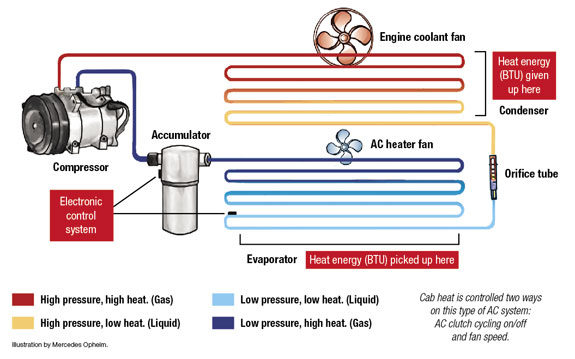Well, summer is quickly flying by, which means that harvest season for some crops is just around the corner. It also means cooler temperatures are in store. How did your air conditioning system hold up this summer? Did the AC system treat you well? I guess the better question here is: Did you treat your air conditioning system well? With temperatures still climbing and staying in the 100-plus temperature range, I think discussing how air conditioners work is an appropriate topic, whether you are on the road or on the farm. Essentially, there are two main air conditioning systems that are used in vehicles. The components of these systems that are most commonly used include the evaporator, accumulator, compressor, condenser and orifice tube.
The ultimate purpose of the air conditioner is to provide cool, dry air by removing the moisture or humidity and the heat energy (btu) from the air inside the cab of vehicles, which happens through a heat transfer cycle.
AC systems are also divided into two different sides: a high-pressure side and a low-pressure side. The accompanying illustration will help you understand the process and flow of the air conditioning system.
How the AC system works
First, the heat energy from the air in the cab is transferred to the refrigerant at the evaporator, causing it to become a gas. The refrigerant goes through a series of changes from gas to liquid back to gas as it cycles through the system. After it leaves the evaporator, the refrigerant, in gas form, goes through the compressor, also known as the heart of the system.
It then goes through the condenser, which cools the refrigerant and changes it back to a liquid. The cooled refrigerant flows through the orifice tube, returns to the evaporator as a cooled liquid and then goes to the accumulator.
When it gets to the accumulator, it is a low-pressure, high-heat gas. Finally, the fan blows the cooled dry air as a heat transfer item from the refrigerant to the cab.
These steps are summarized to mere basics of the AC system. The overall process is much more extensive.
One thing to keep in mind is that the air conditioning system as a whole is a sealed system, operating under its own environment and controlled by heat and pressures. The refrigerants inside the system are also a part of this environment.
By understanding the basics of your AC system, you can head off problems before they begin in the future. In a previous column I wrote for Progressive Forage Grower , I talked a little about the history of air conditioning systems and what to keep an eye on when it comes to your AC system. Read the article at www.progressiveforage.com . PD

-
Jim Schlund
- Retired Diesel
- Mechanics Professor
- College of Southern Idaho







